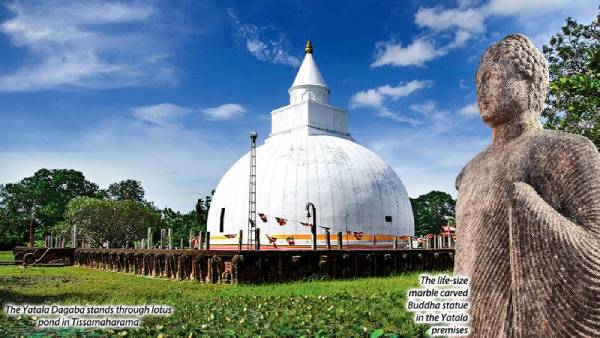Reverence amid tranquility-by Mahil Wijesinghe

Source:Sundayobserver
One of the three regions of ancient Sri Lanka, Ruhuna has its origins in the arrival of Prince Rohana in the 5th Century BC. Rohana gave his name to the territory which was bounded by the sea in the South and the East. Beginning at the Bentara River in West, it stretched along the Mahaweli River encompassing all the land to East. Geographically Ruhuna occupied a major part of the east. Although the chronicles depict Anuradhapura as the most important Kingdom in the country, in the pre-Christian period it is possible that Ruhuna was much larger and more powerful.
 The history of the Kingdom of Ruhuna begins with King Mahanaga, the brother of King Devanampiyatissa. It was King Mahanaga who founded the city of Mahagama, at Tissamaharama. From the 3rd Century BC to the 12th century AC, Mahagama was the capital of Ruhuna. Its ruins are still visible in the area around the Tissa Wewa in Tissamaharama.
The history of the Kingdom of Ruhuna begins with King Mahanaga, the brother of King Devanampiyatissa. It was King Mahanaga who founded the city of Mahagama, at Tissamaharama. From the 3rd Century BC to the 12th century AC, Mahagama was the capital of Ruhuna. Its ruins are still visible in the area around the Tissa Wewa in Tissamaharama.
During the time of King Mahanaga, Mahagama grew into a prosperous city. Similar to Anuradhapura, the city was encircled by monasteries and several large tanks. The largest of these was the Tissa Wewa which was built by King Mahanaga. All around it were Dagabas and monasteries, the Menik Vihara, the Yatala Dagaba and Tissamaharamaya.
Largest Dagaba
After King Mahanaga, the next important figure in the history of the Southern Kingdom was King Kawantissa of 2nd Century BC, the father warrior, King Dutugemunu. He built the greatest Dagaba, the Tissamaharamaya. At the time of its construction, it was the largest Dagaba in the country. Recently, we visited one of the most important archaeological sites in Ruhuna, The Yatala Dagaba at Tissamaharama which is not included in many travellers’ plans in Ruhuna although it is easily accessible from the main road and considered one of the most important archaeological sites in Ruhuna. We took the Wellawaya-Tanamalwila- road to reach this historic site.
After passing the Tanamalwila town and the fast retreating green canopies, the picturesque Wirawila tank is on the side of the road to Wellawaya. The Mattala airport has given the area a modern facelift. The Werawila tank nestles amid the mountainous profiles of the sacred peaks of Kataragama. On either side of this highway are stretches of large paddy fields watered by the Lunugamvehera reservoir. The Yatala Dagaba lies on the right side of the main road to Kataragama before the Tissamaharama town.
Although most of its buildings have disappeared, Tissamaharama remains a city of tanks and Dagabas gleaming from afar. The structures lie buried amid the paddy fields and coconut gardens. The Yatala Dagaba was constructed in the 3rd Century BC by King Mahanaga and its Viharaya was built by King Yatalaya Tissa. It was aptly named Yatalaya Viharaya. Although it seems very plain today, the Yatala Dagaba was once grand and splendid.
Parapet walls
In recent years, it was restored by the Department of Archaeology. The striking feature of the Yatala Dagaba lies in its four imposing parapet walls which have in the foreground, friezes of elephant heads as seen in Ruwanweli Maha Seya in Anuradhapura.
Surrounding the Dagaba were image houses full of finely carved – two Buddha statues, one is a headless torso and Bodhisattvas. All the statues are in standing position and they date between 7th Century and 8th Century.
In one image house on the Eastern side of the Dagaba is a larger than life-size figure of the Bodhisattva which has also been restored by the Department of Archaeology. This figure shows how Mahayana Buddhism had an even greater impact on Ruhuna. Apart from the ruins of image houses, there are numerous upright stone pillars scattered around the Dagaba.
Before approaching the Dagaba, there is a column of stone pillars which take our minds back to the Lovamahapaya in Anuradhapura, popularly known the Brazen Palace. These standing pillars are said to be the remains of a King’s palace and the Audience Hall.
Ecology
Due to the launch of many irrigation schemes in the area over the past few decades, the ecology of the area has completely changed and the water levels have risen around the Dagaba. It is now an island surrounded by water full of lotus flowers.
Another unique feature in the Yatala Dagaba is an Archaeological museum built by the Department of Archaeology which showcases archaeological objects found through excavations in Yatala Dagaba and elsewhere. The Yatala Buddha is one of the most beautiful statues in Sri Lanka which is exhibited in the middle chamber of the museum. The carving is so crisp that the folds of the robe stand out sharply. The statue was made out of dolomite marble in the 8th Century.
The museum also exhibits some artefacts found in Ruhuna and especially in Yatala Dagaba premises. The intricately carved slab inscriptions, Bodhisattva heads, a fine marble carved Buddha head, toilet stone and a clay shower are some of the exhibit items which are unique and magnificent.
Today, Tissamaharama teeming with a big farming and agricultural population is well-developed historical town with all modern facilities. It is one of the bountiful rice bowls in Sri Lanka. Tissamaharama is abooming tourist destination as well.







